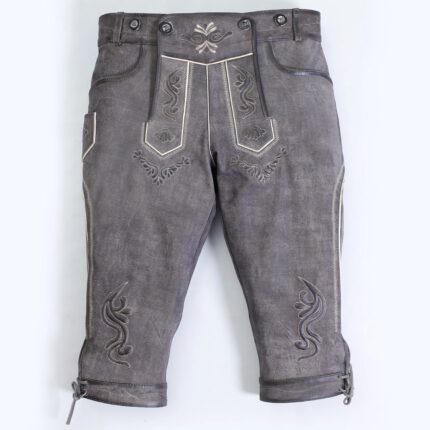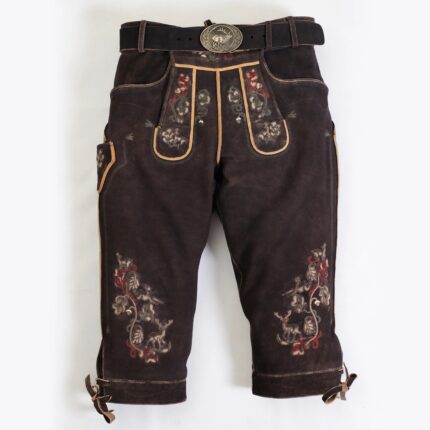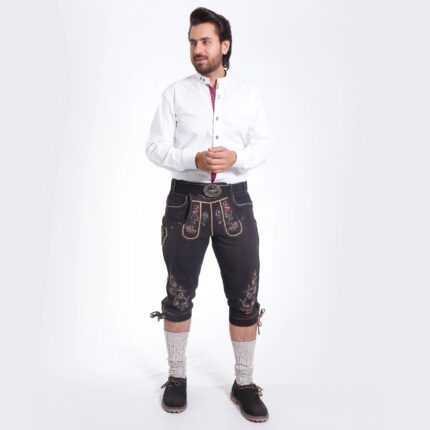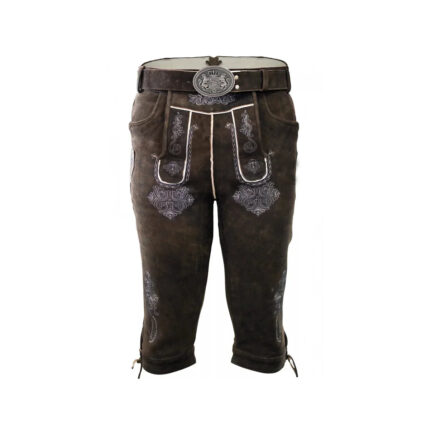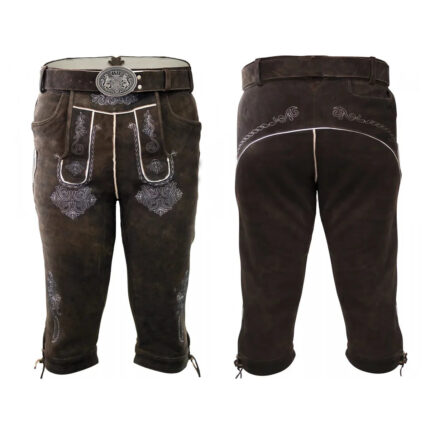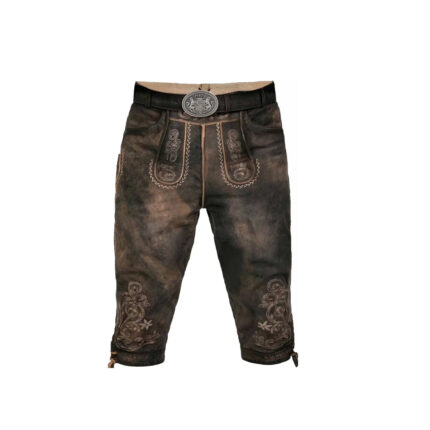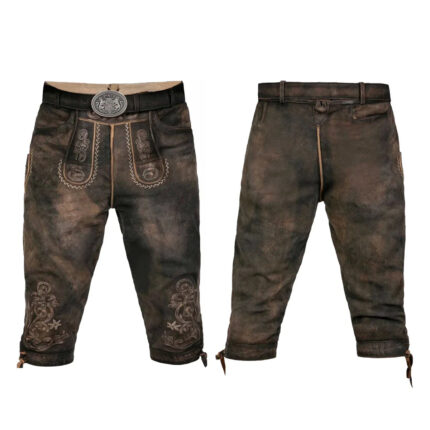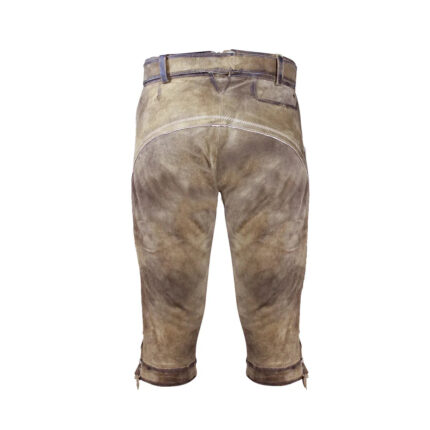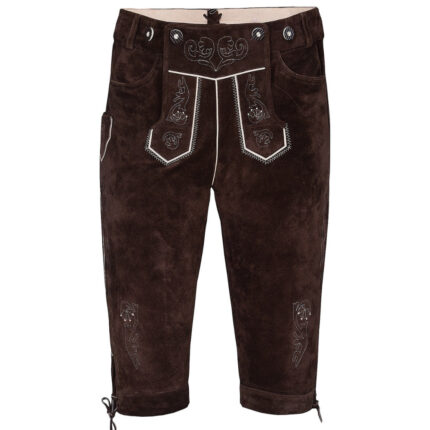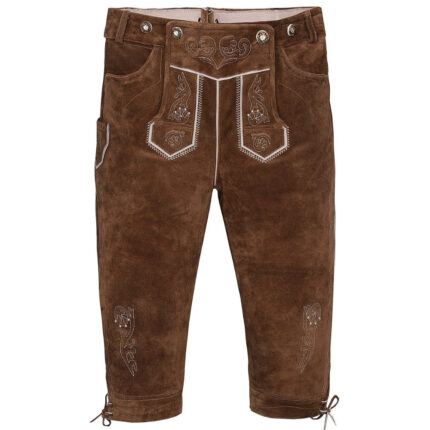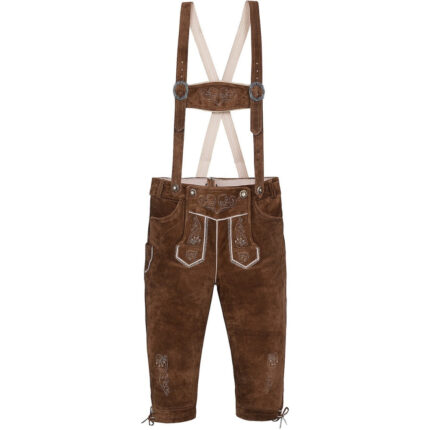Bundhosen: The Comfortable Cousin of Lederhosen in Bavarian Tradition
Bundhosen are a classic example of traditional Bavarian clothing that combines heritage, comfort, and rugged style. Often overshadowed by their shorter counterpart, the Lederhosen, Bundhosen are three-quarter-length leather trousers that extend below the knee and offer more coverage without sacrificing the iconic look of Alpine fashion. Popular among hunters, craftsmen, festival-goers, and even outdoor enthusiasts, Bundhosen are a practical yet stylish choice for those who appreciate authentic German heritage wear. With strong roots in southern Germany, particularly Bavaria, the Bundhose has become a recognizable part of traditional attire worn at Oktoberfest, folk festivals, weddings, and more. Like the Lederhosen, Bundhosen are made from high-quality leather—often deerskin, goatskin, or cowhide—and are characterized by embroidery, side piping, and buttoned leg cuffs. However, their extended length and roomier cut make them more suitable for colder climates or more active lifestyles.
The Origins of Bundhosen in Alpine Culture
Bundhosen have their roots in the alpine regions of Germany and Austria, where rugged terrain and harsh weather required durable and warm clothing. Historically worn by farmers, hunters, and forestry workers, these longer leather trousers provided both protection and comfort during long hours outdoors. Unlike Lederhosen, which were often worn in summer or during festivals, Bundhosen were functional garments suited for everyday tasks in mountain areas. The word “Bund” in German means “band” or “cuff,” referring to the way the trousers are closed around the knee or calf, often with buttons or leather ties. This practical design kept debris and cold air out, making Bundhosen an essential part of the rural alpine wardrobe.
Style and Construction of Traditional Bundhosen
Bundhosen are usually made from genuine leather, with deerskin being the most luxurious option due to its softness and durability. The trousers typically reach mid-calf or just below the knee and often feature hand-embroidered patterns that reflect the region’s heritage. Common embroidery motifs include oak leaves, edelweiss flowers, stags, and hunting symbols, often rendered in green, brown, or cream-colored thread. Bundhosen usually have a traditional drop-front flap, known as the “Hosenlatz,” secured with horn or bone buttons, and side pockets for carrying small items. The cut is slightly looser than Lederhosen, offering more movement and breathability while still maintaining a masculine, structured silhouette. The knee cuffs often include adjustable ties or buttons, making them easy to wear with traditional socks or boots.
Bundhosen vs. Lederhosen: Key Differences
While both garments are pillars of Bavarian traditional wear, Bundhosen and Lederhosen differ in several key aspects. Lederhosen are short leather pants that end above the knee, while Bundhosen extend to mid-calf or below, offering additional warmth and coverage. This makes Bundhosen ideal for spring and fall festivals, or for cooler climates in mountain regions. Style-wise, Bundhosen often come across as more rugged and utilitarian, whereas Lederhosen are associated with light-hearted celebration and festivity. In terms of function, many hunters and craftsmen prefer Bundhosen for their durability and practicality, while tourists and Oktoberfest attendees might choose Lederhosen for their classic festive appeal. However, both are typically worn with similar accessories—suspenders or “Hosenträger,” wool socks, checkered or embroidered shirts, and traditional Haferl shoes.
Bundhosen at Oktoberfest and Other Festivals
Although Lederhosen are more commonly associated with Oktoberfest, Bundhosen have earned a respectable place at Germany’s world-famous beer festival. In recent years, more attendees have embraced Bundhosen for their comfort, coverage, and distinctive look. At colder autumnal events or evening gatherings, Bundhosen are often preferred for their warmth and ease of movement. They are especially popular with older men, families, and traditionalists who seek authenticity in their attire. Bundhosen are often paired with rustic checkered shirts, wool vests, and felt hats adorned with feathers or pins. This complete outfit not only honors Bavarian tradition but also allows for practical movement, whether dancing, hiking to a beer tent, or walking cobblestone streets.
Modern Appeal and Fashion Adaptations
In recent years, Bundhosen have seen a revival beyond folk festivals. Designers are integrating modern touches such as tailored fits, side zippers, and even vegan leather options to make Bundhosen accessible to a wider audience. Urban fashion scenes in Munich and Salzburg occasionally incorporate Bundhosen-inspired designs into casual or outdoor clothing collections. Younger generations, drawn to sustainability and heritage fashion, increasingly favor Bundhosen for their long lifespan, natural materials, and timeless aesthetic. Paired with modern flannel shirts, lightweight jackets, or even sneakers, Bundhosen have found a place in contemporary wardrobes while still paying homage to traditional Bavarian style.
How to Choose the Right Bundhosen
Choosing the right pair of Bundhosen depends on purpose, fit, and material preference. For a truly authentic look, deerskin or goatskin offers unmatched softness and breathability, though cowhide is more affordable and durable. Fit should be snug at the waist but roomy in the thigh and knee area to allow for flexibility and movement. Look for hand-stitched embroidery, horn buttons, and lined interiors for added comfort and craftsmanship. Pay attention to regional embroidery if you want to match the style of specific Bavarian areas. Sizing may vary by manufacturer, so trying them on or consulting detailed size charts is important for the perfect fit.
Caring for Bundhosen to Preserve Their Quality
Because Bundhosen are made from leather, they require proper care to ensure longevity. Always store them in a dry, ventilated place and avoid folding them to prevent creases. After wear, allow them to air out to release moisture and odors. Spot clean with a damp cloth and never machine wash or tumble dry. Use specialized leather cleaner and conditioner to maintain flexibility and color, especially if worn frequently at festivals or outdoors. With proper care, a pair of Bundhosen can last for decades and even become a cherished family heirloom.
Conclusion: Why Bundhosen Remain a Bavarian Classic
Bundhosen are more than just a piece of traditional German clothing—they are a living symbol of Bavarian culture, heritage, and functionality. From their origins as rural workwear to their current status as festival favorites and fashion statements, Bundhosen continue to serve men of all ages looking for comfort, durability, and authentic style. Whether worn at Oktoberfest, during a hike in the Alps, or at a traditional wedding, Bundhosen make a proud and practical statement about the wearer’s connection to Germany’s rich cultural roots. As trends evolve and traditional wear finds new meaning in modern life, Bundhosen will remain an essential element of Alpine fashion and Bavarian pride.

